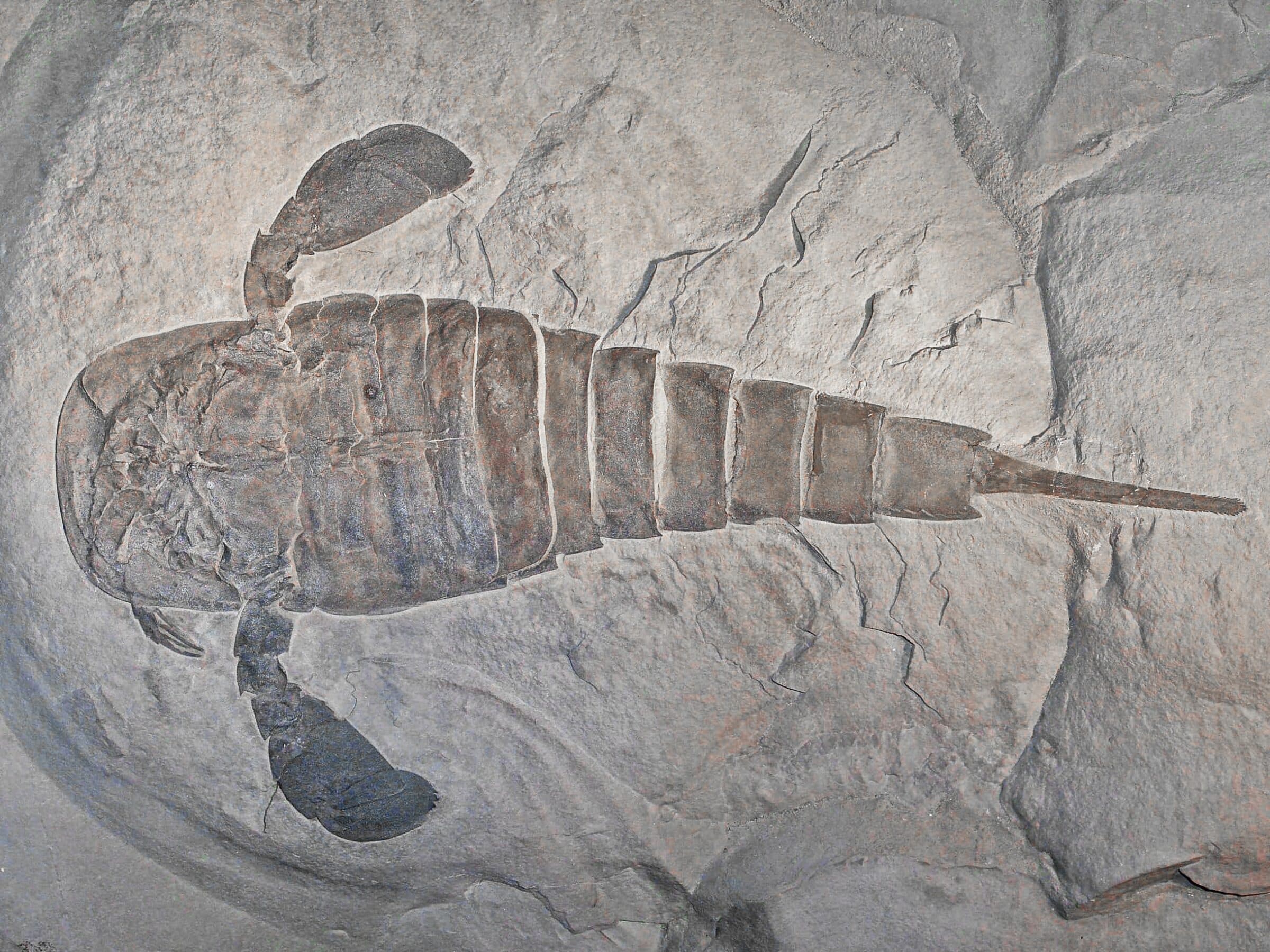 Evolution
Evolution
 Intelligent Design
Intelligent Design
 Paleontology
Paleontology
Fossil Friday: Sea Scorpions Defy Darwinian Expectations

This Fossil Friday features the giant sea scorpion Eurypterus remipes from the Upper Silurian (ca. 410 million years ago) of North America, which was found in great numbers near Buffalo and was chosen as the official State Fossil of New York. It belongs to an extinct Paleozoic group of chelicerate arthropods called Eurypterida, which retained an aquatic way of life and fully developed compound eyes (Schoenemann et al. 2019). In a previous article at Evolution News (Bechly 2023) I discussed in great detail the mess of arachnid phylogeny, which includes many uncertainties about the position of eurypterids and their role in the adaptation of arachnids to live on dry land.
Most experts argued for a position of eurypterids in the stem group of arachnids, while some others rather proposed a closer relationship with certain arachnids, which would imply an independent terrestrialization of arachnids and thus multiple independent origins of the same adaptations (see Lamsdell et al. 2020 and Dunlop 2020). For example, Noah et al. (2020) suggested that “the ancestor of Xiphosura and the extinct Eurypterida (sea scorpions, of which many later forms lived in brackish or freshwater) returned to the sea after the initial chelicerate invasion of land.” Similarly, Ballesteros et al. (2022) concluded that: “Combined analyses recovered the clade Merostomata (the marine orders Xiphosura, Eurypterida, and Chasmataspidida), but merostomates appeared nested within Arachnida. Our results suggest that morphological convergence resulting from adaptations to life in terrestrial habitats has driven the historical perception of arachnid monophyly, paralleling the history of numerous other invertebrate terrestrial groups.” This would be quite remarkable and not at all what evolutionary biologists expected to find.
Even More Evidence for Convergence
Now, a new study by Ruebenstahl et al. (2024), published in the Proceedings of the Royal Society, has found even more evidence for convergence in eurypterids. Apart from their enlarged 6th pair of appendages and a strong tail spine, one of the distinctive characters of eurypterids is their enormous size, which could reach up to 8.2 feet in body length. Gigantism with body sizes over 20 inches occurred in various groups of eurypterids. The new study analyzed 138 of the ~250 known eurypterid species and suggests that “eurypterids evolved giant size independently at least nine times” (Yale University 2024). Why is this significant? Well, convergence is simply a fancy term for similarities that cannot be explained with common descent and modification, thus defying a core claim of Darwin’s theory that similarities are evidence for a common evolutionary origin.
But There Is More
Darwinists previously tried to explain the evolutionary origin of gigantism with various explanations that appealed to the influence of environmental factors. The new study concluded that all these explanations fail and that “there is no compelling evidence that the evolution of giant size was driven by temperature or oxygen levels, nor that it was coupled with the invasion of continental aquatic environments, latitude or local faunal diversity.” Oops, all those cleverly devised just-so-stories turn out to be unsupported evolutionary fairytales. Even the press release by Yale University admits that researchers “may need to go back to the drawing board” (Yale University 2024).
This is rather unsurprising to us Darwin critics, but of course, intelligent design proponents would also predict that the changes towards gigantism did not originate gradually but occurred abruptly with bursts of biological novelty. What does the new study have to say about this? Here it comes: “Eurypterid body size evolution is best characterized by rapid bursts of change that occurred independently of habitat or environmental conditions [my emphasis].” Looks like our prediction is perfectly confirmed by the data, even according to mainstream evolutionists.
No Design Allowed
Of course, the authors of the new study do not consider design as an allowed explanation, but concluded in their abstract that “intrinsic factors played a major role in determining the convergent origin of gigantism in eurypterids.” This sounds very interesting, because unlike many other tentative hypotheses in evolutionary biology it is a very specific and bold statement without any “maybe” or “could be.” Therefore, I checked the actual study for the empirical evidence they found for such intrinsic factors. I was shocked to find only two brief sentences about this in the whole study: “the lack of evidence for a clear driver of gigantism indicates that intrinsic factors may have played a larger role than previously recognized … The pulsed nature of eurypterid body size evolution, potentially driven by intrinsic determinants …” Wait, what? That’s it? Mere speculation based on the fact that they found nothing! You can’t make this stuff up. Sorry, but this is not real science but just some evo drivel masquerading as science. What others have said about origin-of-life research can be extended to evolutionary biology: it is largely a scam.
References
- Ballesteros JA et al. 2022. Comprehensive Species Sampling and Sophisticated Algorithmic Approaches Refute the Monophyly of Arachnida. Molecular Biology and Evolution 39(2): msac021, 1–15. DOI: https://doi.org/10.1093/molbev/msac021
- Bechly G 2023. Fossil Friday: The Mess of Arachnid Phylogeny, and Why I’ve Become More Skeptical of Common Descent. Evolution News December 1, 2023. https://evolutionnews.org/2023/12/fossil-friday-the-mess-of-arachnid-phylogeny-and-why-ive-become-more-skeptical-of-common-descent/
- Dunlop JA 2020. Evolution: A Breath of Fresh Air for Eurypterids. Current Biology 30(21), R1304–R1306. DOI: https://doi.org/10.1016/j.cub.2020.09.052
- Lamsdell JC, McCoy VE, Perron-Feller OA & Hopkins MJ 2020. Air Breathing in an Exceptionally Preserved 340-Million-Year-Old Sea Scorpion. Current Biology 30(21), 4316-4321. DOI: https://doi.org/10.1016/j.cub.2020.08.034
- Noah KE, Hao J, Li L, Sun X, Foley B, Yang Q & Xia X 2020. Major Revisions in Arthropod Phylogeny Through Improved Supermatrix, With Support for Two Possible Waves of Land Invasion by Chelicerates. Evolutionary Bioinformatics 16, 1–12. DOI: https://doi.org/10.1177/1176934320903735
- Ruebenstahl A, Mongiardino Koch N, Lamsdell JC & Briggs DEG 2024 Convergent evolution of giant size in eurypterids. Proceedings of the Royal Society B 291: 20241184, 1–11. DOI: https://doi.org/10.1098/rspb.2024.1184
- Schoenemann B, Poschmann M & Clarkson ENK 2019. Insights into the 400 million-year-old eyes of giant sea scorpions (Eurypterida) suggest the structure of Palaeozoic compound eyes. Scientific Reports 9(1): 17797, 1–10. DOI: https://doi.org/10.1038/s41598-019-53590-8
- Yale University 2024. Findings reveal eurypterids evolved giant size independently at least nine times. Phys.org August 13, 2024. https://phys.org/news/2024-08-reveal-eurypterids-evolved-giant-size.html
